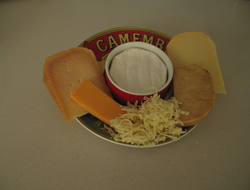Cheese: Variety, versatility and nutritious, but beware
Published: October 11, 2019
Cheese, a fermented dairy product, is valued as a food not only for its nutritional content, but also for its versatility such as usage, portability, stability, and shelf life.
Cheese is also valued for the variety of flavours and textures the many cheese varieties provide the cheese consumer.
While most often processed from cow’s milk, sheep, goat, and buffalo milk are also used to produce cheese.
Cheeses range from very hard to creamy in texture and colours from off white, to yellow, to red, and to brown.
Some are identified as “blue” due to the blue veins which develop during processing.
Moving clock wise on the cheese platter the cheeses are smoked Gouda, Havarti, grated Mozzarella, Cheddar, goat Gouda, and in the centre Camembert.
Cheese is essentially a concentrated form of milk which goes through a fermentation process initiated by various microorganisms: different strains of bacteria.
Fermentation process
During the fermentation process the bacteria breakdown carbohydrate present in milk usually under anaerobic conditions.
Commonly used bacteria are lactic acid and propionic acid bacteria. Some cheeses require an additional strain of bacteria which is heat resistant if the cheese making process requires heat.
The type of bacteria used and the cheese production method effect the final cheese product.
Cheese processing also requires a coagulating agent such as traditional rennin (chymosin), recombinant chymosin, and in a few cheeses vinegar or lemon juice.
Rennin or chymosin are enzymes. Rennin is obtained from the stomachs of calves whereas recombinant chymosin is obtained from genetically modified microorganisms.
The gene that codes for chymosin is transferred to specific microorganisms which are cultured to produce chymosin. The recombinant chymosin is isolated from the culture and purified for sale to cheese makers.
Recombinant chymosin has been thoroughly tested for safety and is approved in North America as safe to use.
Fermentation of Mucor miehei (a fungus) produces a vegetarian alternative to rennet.
The cheese making process usually begins with pasteurization of milk, however some cheese manufacturers omit this first step.
Fermentation and coagulation follow after which the curd (coagulated milk) is separated from the whey (liquid). This is almost the end of cheese...Link to the full article to learn more.
References
1.
Whitney, E. & Rady Rolfes, S. (2005). Understanding Nutrition. Belmont, CA: Thomson Wadsworth
2.
Food preservation with biotechnology (FNH200 UBC, 2005)
3.
Centre for Science in the Public interest July/August 2015, April 2012, March 2012
4.
Centre for Science in the Public Interest http://www.nutritionaction.com/daily/food-safety/soft-cheeses-linked-to-listeria-
5.

